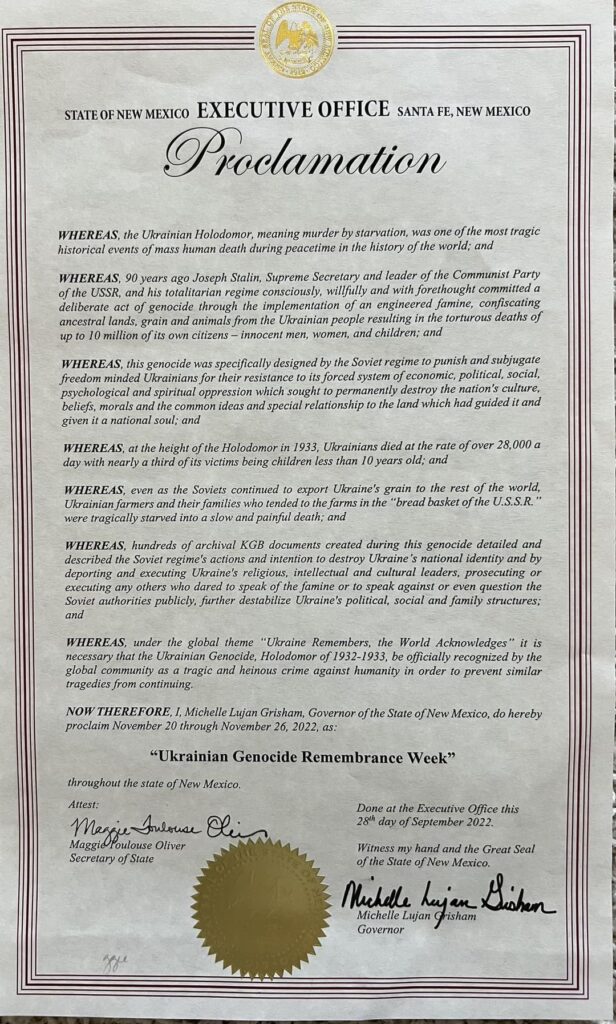International Holocaust Remembrance Day

International Holocaust Remembrance Day, December 27th 2023
The Holocaust, also known as the Shoah, was the genocide of European Jews during World War II. Between 1941 and 1945, Nazi Germany and its collaborators systematically murdered some six million Jews across German-occupied Europe; around two-thirds of Europe’s Jewish population.
Carol of the Bells – Ukrainian Bell Carol
How This Ukrainian Song Became a Christmas Carol you know and love.
This song with roots in Ukraine has become a classic song for Advent and Christmas in the United States.
This year, “Carol of the Bells” is celebrating the 100th anniversary of its premiere in the United States. When it debuted, it was not a Christmas carol yet — that would come a few years later. Its first performance came on Oct. 5, 1922, at New York’s Carnegie Hall to a sold-out house — the same venue where it will again be featured in a concert Dec. 4 to mark its momentous centennial.
At that 1922 debut it had its original Ukrainian title — “Shchedryk” — meaning “generous evening.” It was really a festive New Year’s song taken from Ukrainian folk tradition. But the musical foundation was there for its transformation into the popular Christmas carol in 1936.
The song was composed in 1914 by one of Ukraine’s major composers, Mykola Leontovych. He based the melody on traditional folk songs. It was originally commissioned for the Ukrainian Republic Choir by its choir director for a Christmas concert. It was an immediate hit in Ukraine.
Then, just as Ukraine was getting its feet on the ground after World War I, the year 1917 saw the overthrow of the Russian tsar in the Bolshevik revolution. The Soviets refused to recognize Ukraine as a country and invaded, occupying Kharkiv in early 1919.
To familiarize the world with the Ukrainians’ plight through international appearances, the same choir director who commissioned “Shchedryk” formed the new Ukrainian National Chorus to tour Europe, the United States and several other countries. In the United States alone the choir appeared in 115 cities across more than 35 states. The chorus also made the first recording of “Shchedryk.” No matter where the choir sang, “Shchedryk” was an outstanding hit. Concertgoers everywhere called for it to be sung for an encore.
With lyrics inspired by an ancient Ukrainian folk traditions, the song is about a swallow flying into the house to tell the family about the bountiful year coming up for them. For those politically uncertain and harsh times, that message was uplifting in Ukraine. But the meaning did not matter for audiences around the world, who did not know what the Ukrainian lyrics meant, but were completely enthralled by the music and singing.
Change to Christmas Carol
Then came 1936 and the birth of “Carol of the Bells.” In New York, well-known choral director Peter Wilhousky, who was born in New Jersey of Ukrainian ancestry, did the choral arrangements for the popular radio broadcasts of Arturo Toscanini’s NBC Symphony Orchestra. Needing another piece to fill out a program, Wilhousky turned to a piece of music familiar to him. Naturally, it was Leontovych’s “Shchedryk.” But he knew the choir couldn’t sing it in Ukrainian.
He had an idea. Since the melody reminded him of bells ringing, Wilhousky sat down and wrote lyrics about bells and Christmas for the song. The carol begins, “Hark! how the bells …” Naturally, it also includes “Christmas is here … Merry, merry, merry, merry Christmas.” It was an instant hit with the public once they heard it on the national airwaves.
Requests for the sheet music came pouring in. Wilhousky had it published for distribution. Soon it was being performed on radio and being recorded by choirs like the Robert Shaw Chorale and the Tabernacle Choir. In 1951 even radio’s Phil Spitalny and his All-Girl Orchestra and Choir recorded it. (Likely he was already familiar with the melody because he had emigrated from a town in the Kyiv Region in Ukraine.)
Dozens of adaptations have been made to the carol, from recordings featuring a single instrument to a children’s choir to a huge youth orchestra to a singalong. There was even a version featuring new lyrics by a relativity unknown musician in 1947 that emphasized the Nativity of Jesus Christ and the religious significance of Advent and Christmas.
Uplifting Message
Then and now, this carol has contained a message of joy and hope, even in the sad circumstances of its composition in Ukraine.
By definition, a carol is “a popular song or ballad of religious joy.” And as a verb, another definition is “to go about outdoors in a group singing Christmas carols.”
The lyrics describe the bells playing “with joyful ring … all caroling,” and says, “joyf’’ly they ring … while people sing songs of good cheer … Christmas is here.”
Joy should spark hope — something that was necessary with the situation both in Ukraine and the world when the carol was written, then on through the Depression years when it became popular as a new Christmas carol, and now in our time. The carol reminds us of the joy of the season and suggests the hope that comes with it.
For its 100th anniversary celebration in the United States, “Carol of the Bells” will return to Carnegie Hall, where it was heard for the first time in this country. Naturally, a Ukrainian choir will be performing it and other works. Surely it will bring the house down.
But more importantly, whenever you hear “Carol of the Bells” this year, say a prayer for Ukraine that hope will abound and that peace and joy will return to that country — and to the world — with the celebration of the birth of the King of Peace.
Holodomor Memorial Day, 1932-33
Santa Fe Plaza .
Holodomor Memorial Day, 1932-33
Thanks for everyone who came and support us .
90 years on, Ukrainians see repeat of Russian ‘genocide’
The attacks caused the worst damage so far in the conflict, leaving millions of people with no light, water or heat even as temperatures fell below zero.
Ukrainian Genocide Remembrance Week

New Mexico’s Governor Michelle Lujan Grisham proclaimed November 20, 2022 through November 26, 2022 “Ukrainian Genocide Remembrance Week”.
The Ukrainian Holodomor (1932-33) was one of the most tragic events in the history of the world. In acknowledgement of its scale, the famine of 1932–33 is often called the Holodomor, a term derived from the Ukrainian words for hunger (holod) and extermination (mor).
Millions died a slow and painful death during peacetime in Joseph Stalin’s man-made famine/genocide while the Soviets continued exporting Ukraine’s grain to the rest of the world.
The Soviets and the Russians tried for many decades to conceal this atrocity from the world.
Today, the whole world watches in horror as Putin’s war/genocide against Ukraine devastates Ukraine once again trying to deny them their God given and sovereign Right to Life as a free people.
Stephan J. Welhasch
Press Secretary, UAofNM
Happy and Proud Veteran’s day

Appreciation and love to everyone who fought for the country and gave their lives .
We owe so much to them.
The US’s history of fighting against the odds inspires Ukrainians today to fight back against Russian tyranny.
Thanks for the many American veterans who have volunteered to fight in Ukraine, as well as the American people’s amazing support.
Have a very Happy and Proud Veteran’s day!
Day of the Ukrainian Language and Writing
Yesterday we celebrated the Day of the Ukrainian Language and Writing. Ukrainians all over the world have traditionally written a dictation of national unity. It is impressive that even our defenders found the time and opportunity to join this important tradition. People who care so much about their language and culture, even in the face of a terrible war, cannot be defeated.
Ukraine will win!
